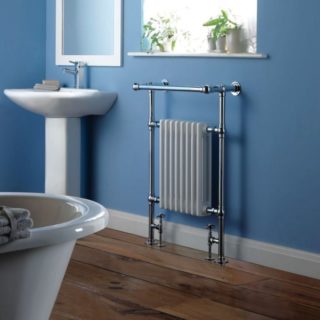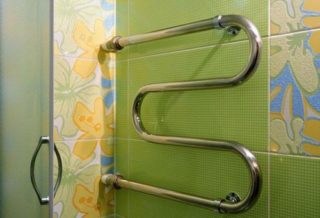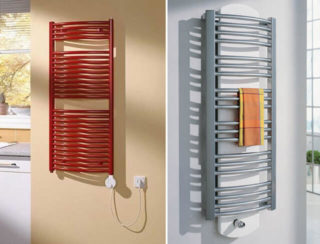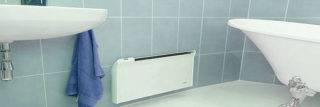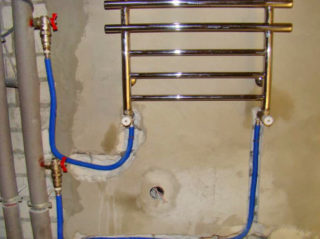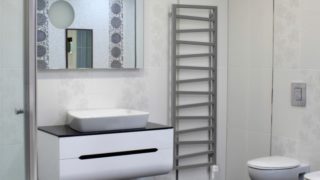A prerequisite for the convenience of using the bathroom is a microclimate with a comfortable temperature. The creation of such conditions is impossible without a source of dry heat, which is traditionally used classic heating radiators.
The main types of bathroom heating appliances
The bathroom belongs to rooms characterized by a high level of humidity, therefore, the wall-mounted battery in the bathroom is selected so as to obtain the necessary dry air and a suitable temperature. It is important to familiarize yourself with the existing varieties of heating appliances in detail. The batteries in the bathrooms have the following designs:
- cast iron;
- steel;
- aluminum;
- bimetallic.
Massive cast-iron batteries do not look very comfortable in a small room, creating an impression of discomfort. But they are distinguished by increased heat dissipation, as well as long service life and relatively low cost. The best option for the bathroom is cast iron radiators with a powder coating. The structure of the latter includes fragments of polymers and ceramics, allowing to obtain a strong protective layer of an attractive appearance.
Steel heaters are not very suitable for the bathroom due to the possibility of corrosion of unprotected work surfaces. In conditions of high humidity in the affected areas, foci of rust form, eventually thinning the walls of the radiators. This often leads to the formation of a leak, the likelihood of which increases with high pressures in the heating system.
An aluminum radiator in the bathroom is almost an ideal option for organizing its heating. These products are lightweight, reliable and small in size. Aluminum radiators and drying units are strong enough to withstand the water shocks that often occur in any heating system. Their only drawback is that when docked with pipes of a foreign metal, aluminum corrodes and collapses over time.
All of these shortcomings are deprived of bimetallic water radiators for the bathroom, made on the basis of two metals - steel and aluminum. The base or frame of the radiator is made from the first material, and the outer frame (shirt) is made from the second.
Due to the combination of two metals, the service life of bimetallic products increases to almost 20 years. Features of their design allow to partially offset the shortcomings of Russian heating systems.
Types of wall equipment and their device
Wall-mounted heating radiators, operated in conjunction with underfloor heating, are common in bathrooms. In this combination, they are more effective and allow you to maintain the desired level of humidity, dry clothes. Significantly expand the functionality of heating devices help various options. The most famous for most users is a battery made in the form of a heated towel rail. Devices of this class fit perfectly into the design of a room with a warm floor and allow you to dry various household items.
There are three types of heated towel rails:
- water;
- electric;
- combined.
Water heated towel rails resemble previously common coil-type batteries mounted in bathrooms in Soviet times.In contrast to obsolete samples intended for drying small things, modern varieties of heating radiators look more stylish and attractive. They are an elegant chrome construction, connected to hot water supply or heating. The coil of the modern device is made of stainless steel, which guarantees its safety in damp and humid climates. Often heated towel rails from more expensive materials - copper or brass - are connected to centralized heating systems.
Electric models
If there is no water heating or a hot water supply system in the apartment or private house, an electric heated towel rail is installed in the bathroom. For its normal functioning, it is enough to connect such a battery to an alternating current network with an operating voltage of 220 volts. In this case, a heating element is mounted in the tube of the serpentine device, which heats the water flowing through it.
The power consumption for such a device is not too large. It is comparable with the same indicator for an average incandescent bulb. When placing it, it is important to fulfill the following requirements of electrical standards (PUE):
- The radiator in this design is installed on the wall no closer than 0.6 meters from the bathtub, sink, bidet or toilet.
- It is obligatory to install an RCD protective device on the power line of the heated towel rail to a leakage current of not more than 30 milliamps.
- The power plug of the device and the power outlet are necessarily equipped with a grounding terminal and have a degree of protection of at least IP55.
Attention is also paid to the design of installation products, the design of which should not violate the interior of the bathroom.
Combined Option
A feature of combined structures is the permissibility of their simultaneous connection to the power grid and water supply. In winter, they work from a source of hot water, and in the summer they connect to a power outlet. The advantage of these devices is manifested in the ability to economically exploit sources of thermal energy.
When choosing a suitable model of a combined heated towel rail, the main attention is paid to the following characteristics:
- power of the built-in heating element, which should not be less than 1 kW;
- the preferred material of the device is stainless steel, resistant to corrosion and moisture;
- correspondence of seats to the sizes of fittings for water supply pipes.
Be sure to take into account the shape, dimensions and design of the combined product.
Recommendations for connecting the wall battery to the bathroom
The procedure for connecting a heated towel rail depends on its type. The water radiator is connected via a bypass, the presence of which allows you to organize a bypass loop with the heating system turned off. In addition, in this case, attention is drawn to the following points:
- To shut off the dryer during the shutdown of heat supply, it is recommended to install ball valves. They are easy to maintain, hold the pressure well and have a great response resource.
- To connect the dryer and the radiator, it is not shafts that are used, but a special type of nut - an American.
If these conditions are met, it takes very little time to install the water wall-mounted battery.
Electric heater
Electric dryers with a capacity of 1000 watts are allowed to be connected to any outlet, regardless of the presence of grounding and the section of the wiring. For more powerful heaters, you will need to install special sockets that satisfy the following requirements:
- There must be a separate terminal connected to the ground loop through a special copper bus.
- The socket mounted in the bathroom must have a sealed cover that protects the inside from water splashes and moisture.
- The wire is selected taking into account the consumed power (its cross section is determined according to the correspondence tables).
In the supply line of dryers in the bathroom, a protection device that is triggered by current leakage (RCD) must be installed.
Rules for choosing equipment
When choosing heating radiators, preference is given to appliances that can heat the room and dry clothes. However, it is desirable that they fit well into the interior of the bathroom. According to the design features and the shape of the bending of pipes, standard products are divided into two types, one of which resembles the letter "P", and the other - "M". The choice of one or another option depends on the user's preferences.
Industry produces more modern designs that are distinguished by the originality of their forms. Such heaters are made in the form of a zigzag or resemble the shape of a stair run.
It is recommended to purchase a device in which the number of drying places corresponds to the number of users living in the house.
There are samples of drying units with advanced functionality - they contain convenient shelves for toiletries in the kit.
